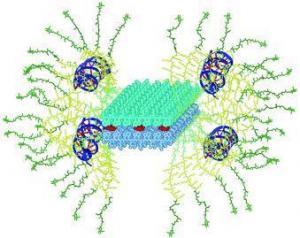Artificial viruses carry gene molecules and pharmaceuticals into tumors
Viruses are real professionals who implant genetic material into infected cells. This feature is currently exploited in gene therapy.
Genes are carried into a patient's cell to cure genetic diseases or defects. Korean researchers have created an artificial virus. As described in Angewandte Chemie, they can use it to transfer genes and drugs into the cancer cells.
The natural virus is extremely effective for gene therapy in transporting genes into cells; but they can give rise to a resistance or cancer-causing reaction. Artificial viruses do not have these side effects, but are not as effective as natural viruses because their size and shape are difficult to control - but are crucial to performance. The study, led by Myongsoo Lee, has developed a new strategy that allows artificial viruses to maintain their defined shape and size.

The researchers began with a ribbon-like protein structure as a template.The self-organizing protein ribbon has two layers to create the shape and size.It is tied to an external 'protein arm' that binds to the RNA helix helix. (Photo: Wiley-Blackwell)
The researchers began with a ribbon-like protein structure as a template. The self-organizing protein ribbon has two layers to create the shape and size. It is tied with an external 'protein arm' that acts as an RNA helix helix. If RNA is used to complement a specific gene sequence, it can inhibit the process of reading the gene. There is also the name ARN that interferes with short fibers (siARN), which promises a new way to advance gene therapy.
Glucose block on artificial virus surface improves the bonding between artificial virus and glucose transporter on target cell surface. These transport blocks are present in most mammalian cells, particularly concentrated in large numbers on tumor cells.
Experiments with several types of cancer cells have demonstrated that artificial viruses are very effective in transporting siRNA and blocking the target gene.
In addition, the researchers were able to attach hydrophobic molecules (hydrophobic substances) - the purpose of color expression - to artificial viruses. The dye is introduced into the nucleus of tumor cells. This is particularly interesting because the nucleus is the target of many important anti-tumor cells.
- Use 'sex virus' to kill brain tumors
- Create artificial molecules against drug-resistant bacteria
- Animals carry at least 320,000 dangerous virus species
- Find out the cause of extremely fast resistant cancer tumors
- New medicine helps restore cirrhosis patients
- The place of preparation of radioactive pharmaceuticals of serious diseases
- Prevent gene exchange bacteria: A smart solution for drug resistance
- USD 750,000 from NASA for anyone who finds a way to turn CO2 on Mars into other molecules
- Science makes a virus that kills cancer cells, a major turning point for mankind?
- Strange story: Smiling face on the tumor
- Semi-artificial microorganisms - New breakthrough in molecular biology
- New techniques help increase the effectiveness of artificial insemination
 Why do potatoes have eyes?
Why do potatoes have eyes? 'Tragedy' the world's largest carnivorous life: Death becomes ... public toilet
'Tragedy' the world's largest carnivorous life: Death becomes ... public toilet Tomatoes were once considered 'poisonous' for 200 years
Tomatoes were once considered 'poisonous' for 200 years Detecting microscopic parasites on human face
Detecting microscopic parasites on human face